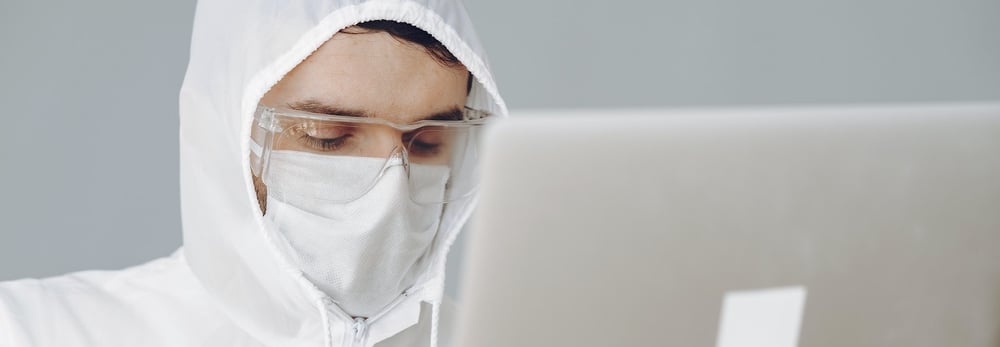The Future of Telemedicine in Healthcare

New developments in AI technology and big data analysis allow for automation and improvement in areas such as:
- Digital diagnostics,
- Real time health data acquisition and modeling,
- Customer experience (with personalized contact and advertisement).
These improvements are already being implemented, while researchers continue looking for even better solutions.
But how will it all develop in the longer perspective? What can telemedicine become in the next decade or two?
One thing is certain: more and more health-related activities will move to virtual reality, and more decision-making will be supported by data and AI algorithms.
Patient communication
AI-based communication - for medical surveys, making appointments, and data management - is becoming an increasingly popular element of healthcare software platforms. Setting up meetings takes time, but with AI assistants patients can use the power of digital solutions to manage appointments in seconds.
Google is among the top innovators in this area. Experiments at Google I/O show that it’s possible to make an appointment with a hairdresser or a reservation at a restaurant entirely through Google Assistant.
The AI is sophisticated enough to understand conversational nuance, ask relevant follow-up questions, and sound like a real person. In the future smartphones will likely be much more powerful, allowing for even more sophisticated interactions with users and making people more willing to use such solutions.
Remote data gathering
We’re moving towards overcoming the physical limitations of medicine. AI-based patient monitoring in real time can be used to improve reaction speed and diagnostics while providing more personalised care.
IoT solutions will gather a constant data stream of patients' health parameters, channeled straight to doctors. Effective reporting will translate the data into efficient summaries and map symptoms across selected periods. Data that has a unified structure and is widely available (thanks to cloud based solutions) will allow world-class specialists to help in urgent cases regardless of their patients’ geographical location.
Multiple micro biosensors will gather not only pulse, heart rate or temperature measurements, but also USG data through ingestive biosensors, and camera views of a patient’s bloodstream or digestive tract. The MyTMed System is an example of working to leverage this sort of data to battle nonadherence to medication in cases of chronic disease.
Other types of biosensors include enzyme-based and tissue-based ones, immunosensors, DNA biosensors, and thermal biosensors. They can be used to detect early-stage causes of heart disease or viral infections.
Another kind of smart monitoring can be used for early diagnosis of neurodegenerative diseases. Email analysis focused on word patterns and misused words, characteristic for dementia, CJD and similar conditions, can help determine the presence of symptoms regardless of the patient’s location.
Speech analysis used for detecting indicators of Alzheimer’s disease has been found to be incredibly accurate (between 82% and 100%). Diagnosing Parkinson’s can be made easier with walking and movement pattern analysis performed by a smartphone app, such as Patana AI. More than 10 million people live with this disease, and early detection could help them tremendously by slowing Parkinson’s progression.
Online diagnosis
At-home diagnosis can happen thanks to multiple types of data. AI-assisted smartphone cameras can be used to detect skin cancer. Voice-based diagnosis can help with detecting afflictions of the respiratory system, while speech analysis allows for complex neurological assessments.
Ionophore-based optical sensors (IBOS) are easy to miniaturise and relatively cheap to produce. These and other biosensors coupled with summaries of data they obtain across a length of time allow for basing diagnoses on detailed 24/7 health parameter tracking. This can improve accuracy and allow for a wider implementation of preventive and proactive care.
Digital therapeutics and remote treatment
Currently, medical treatment can be assisted by digital therapeutics - apps that help with medicine dosage or provide additional solutions. These apps have been successful in the treatment of ADHD, for example.
They work on multiple levels that are integrated with patients’ lifestyles, and deliver a number of therapeutic solutions:
- Assistance for patients requiring insulin,
- Virtual reality systems for treating mental illness,
- Chaperone systems to teach and maintain healthy habits.
But this is only the first step. Using transdermal or body implants, doctors could remotely manage medicine delivery. Supported by biosensor data, this type of treatment could vastly improve personalisation, prevention, and patient convenience, while limiting the negative effects of nonadherence to medication.
Remote surgery
Robotic surgery is already here. With the da Vinci Surgical System, doctors can use an advanced console that improves the outcomes of surgical procedures and facilitates a minimally invasive approach. The console requires a human operator, but in the future, this operator could be anywhere in the world while performing surgery with automated robotic arms.
Conclusions
The future of telemedicine is bright. By implementing wide-scale remote solutions, healthcare providers will be able to improve communication with patients, leverage big data and precise biosensing technologies, provide online diagnoses, and treat patients across large distances.
Such a proactive approach to medicine will result in better outcomes, improved care accessibility, and more effective use of medical resources. Doctors will have more control over treatment and be able to apply preventive measures more widely, battling the growing global spread of chronic diseases.



...%20hero.jpg?width=415&height=415)


